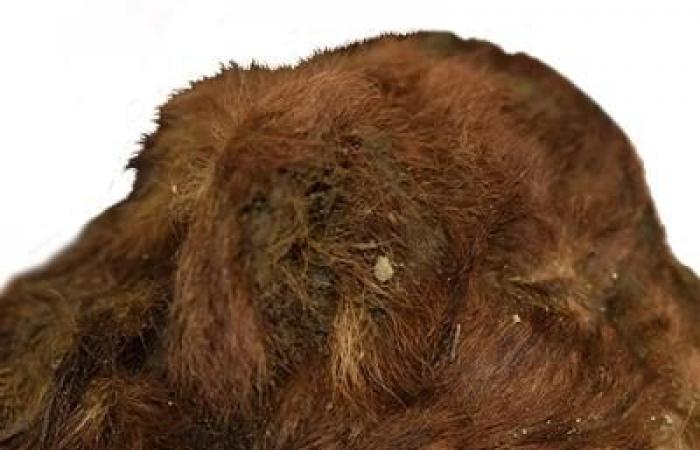Paleontologists have been wondering what saber-toothed cats really looked like for nearly two centuries. Indeed, despite the models exhibited in museums, the spectacular works of paleoart and their representation in films Ice Ageexperts actually only had fossilized bones and rare footprints to try to imagine the true appearance of these extinct predators. However, the recent discovery of a kitten frozen in Siberian permafrost allows us to finally get a glimpse of this feline, which roamed the northern hemisphere around 32,000 years ago.
“I was so happy to see such an incredible specimen,” says Ashley Reynolds, a paleontologist at the Canadian Museum of Nature, who was not involved in the new research. Although mummies of mammoths and other herbivores have been discovered in the same region of Russia in the past, it is much rarer to find remains of apex predators, as prey typically outnumber predators in the wild. This is why the unearthing of a saber-toothed cat mummy has always seemed unlikely to paleontologists.
In 2020, “the carcass, frozen and mummified, was found by excavators who were looking for mammoth tusks,” explains paleontologist A. V. Lopatin of the Russian Academy of Sciences. Lopatin and his colleagues were “surprised and delighted” to study the specimen, which they described in an article published November 14 in the journal Scientific Reports.
The prehistoric animal not only offers the very first glimpse of what saber-toothed cats actually looked like, but also represents a period in the species' life that is far less known to paleontologists, with most fossils found so far belonging to adult individuals, notes Reynolds.
Lopatin and his co-authors determined that the “kitten” belonged to the species Homotherium hiding. This carnivore, sometimes nicknamed “scimitar cat”, was a slender and very widespread predator which, rather than practicing hunting by ambush as the famous Smilodon, tended more to chase after its prey. Present in Eurasia and North America, the feline hunted young mammoths and other megafauna species. Fossil sites, such as Friesenhahn Cave in Texas, even suggest that they sometimes built dens in caves to raise their young.
In the absence of fossils including soft tissues such as fur, muscle and skin, paleontologists have long debated the supposed appearance ofHomotherium. They were thus often represented with long canines protruding from their mouths, which was perhaps true for certain species, such as the Smilodon. An analysis carried out in 2022, however, suggests thatHomotheriumfor its part, had a deep mouth and an upper lip which covered its long teeth, which thus became “hidden weapons” when the animal had its mouth closed.
In the case of this mummy, it is difficult to know whether the fangs of the Homotherium hiding adults were or were not covered. According to Lopatin, the kitten's upper lip is more than twice as deep as that of a modern lion cub, suggesting thatHomotherium actually had lips capable of hiding his long canines, which would only grow later. Reynolds nevertheless specifies that the kitten found in Siberia did not yet have its adult teeth. Only the mummy of an adult “sabre-toothed cat” will allow this debate to be resolved, and such a discovery now seems more likely thanks to the unearthing of this young individual.
In other respects, the specimen's anatomy confirms what paleontologists expected based on the bones already analyzed. “The kitten's neck had hypertrophied muscles that we actually thought were found in adults, and its forelimbs were long and muscular, as we had already seen in adults. Homotherium adults,” describes Margaret Lewis, a paleontologist at Stockton University in New Jersey, who was not involved in the new study. The calf's jaw could also open very wide, an ability that adults used to bite their prey, she notes.
The color of the animal, too, was a mystery to specialists. The coat color of modern felines is generally associated with their hunting environment: lions, pumas and cats that live in open, grassy habitats, for example, often have light, relatively uniform coats. Homotherium, that hunted in the “mammoth steppe,” a cold environment with few trees but lots of grass, would therefore have to have a coat capable of blending into large, open spaces.
“The uniform dark brown color of the mummy's fur turned out to be completely unexpected,” admits Lopatin. Like a group of cave lion cubs discovered several years ago in the permafrost, the cubs Homotherium were probably born with a darker coat that lightened over time.
“It's fascinating to see that the pups' coats didn't appear to have any spots or stripes,” says Reynolds, because these types of patterns are common among modern felines, even in species that have more uniform coats at adulthood. Lewis notes, however, that frozen animals often display a reddish tint: so it is possible that the specimen's current coat does not reflect the colors it exhibited when alive. Perhaps genetic analyzes of the fur will help provide better insight into what it actually looks like.
Experts will continue to examine the kitten for some time. This is the first time that an Ice Age mummy belonging to a species of mammal has been unearthed which has no modern equivalent, and which therefore cannot be compared. Saber-toothed cats, which specialized in hunting mammoths and other megafauna, became extinct when their prey succumbed to the combined effects of climate change and human activity. No feline hunts like them anymore these days. The soft tissues of the fossil therefore reveal many details that paleontologists could previously only imagine based on studies of simple bones found in the past.
The kitten's tiny paws also reveal new information about the animal. “Each pad is much rounder than a lion's,” notes Reynolds, and the specimen lacks a carpal pad, which is found a little higher up on the paws of modern felines. Although the cause of this difference is unknown, studying it could help specialists better identify the characteristics that distinguish saber-toothed cats of the past from the big cats that inhabit our planet today.
Homotherium and the other species in its family were not just simple lions with very long teeth, but predators who lived in a world very different from ours, inhabited by giant and strange creatures that are now extinct. This ancient mummy gives us a first-hand glimpse into that ancient, bygone era when saber-toothed cats dominated the plains of the northern hemisphere.






